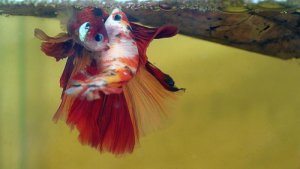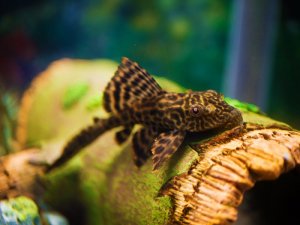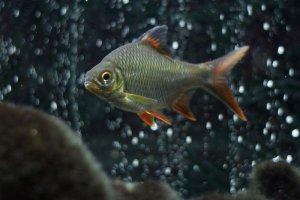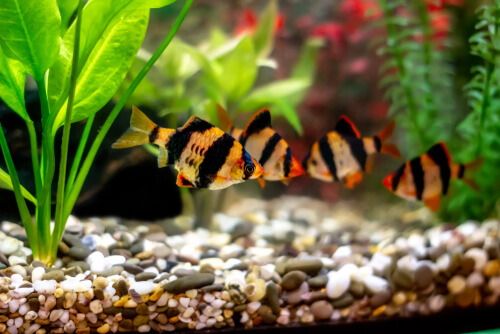
Barb fish come in many sizes, and some can grow awfully large which means you will need a much bigger tank. Nevertheless, if you like this peaceful schooling species, but do not have the tank space, I have very good news for you, there are rather a few significantly smaller barb species that are under 2 inches (5.5cm) that you can easily keep in a small well-planted tank or even a nano tank.
I normally also find that the smaller barb fish species are much more colorful and intricate in markings, making them very attractive for any aquarium. Their friendly nature and energetic nature have placed them top of the list of some of the most popular tropical freshwater fish as pets.
Overall, most barbs have much similar care necessities which I will first go into light detail, and then we can carry on to our list of some of the smallest barb species for your aquarium.
Breed Overview
| Origin | West Africa, Congo, Myanmar, India, Thailand, Bangladesh, and Pakistan. |
| Lifespan | Between 1-5 years depending on the species. |
| Size | Sizes are all under 6 cm (2 Inches), between 4-5 cm (1.98 Inches – 1.4 Inches). |
| Colors | Color Variations Available According to Species. |
| Food | |
| Tank Size | 10-30 Gallons. |
| Temperament | Mostly Peaceful, Schooling, and Active. |
| Water Temperature | Lower temperatures between 16.7 ̊C – 27.8 ̊ C (62 ̊ F – 82 ̊ F). |
| Water pH | Between pH 5.0 and pH7.5 |
| Difficulty Level |
Smaller Barb Fish Species
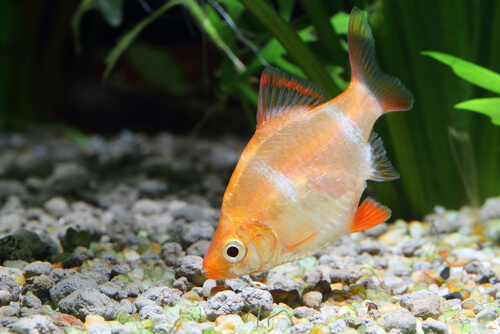
Barb fish in general are very peaceful shoaling fish that do well in community tanks. They are from a large group of fish species called the Cyprinidae family.
Barbs, whether smaller or larger, need to be kept in groups of five or more, and up to eight or more in the much smaller barb species. There is a huge variety of barbs available in all sizes, from countries including West Africa, Thailand, and even India.
Smaller barbs need to be kept in groups to prevent them from becoming aggressive toward other tank mates. They are mostly peaceful but may nip at other fish that have long-flowing fins.
The purpose of this article is aimed to help you find the best smaller barb species for your tank, so I have only included barb species that are under 2 inches (5.5cm) in size for community tanks.
But before we can get into the specific species, let us first look at some general care guidelines for smaller barbs specifically;
General Care
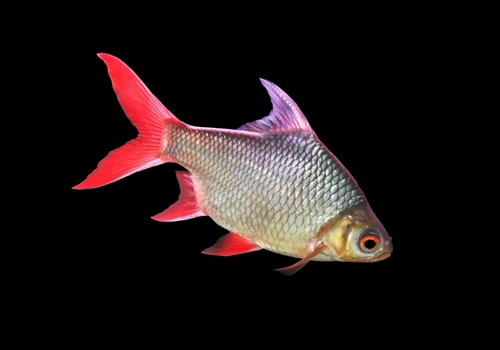
Under the right conditions and with proper feeding most smaller barbs should live between 1 and 3 years depending on the species, and some even up to five years with optimal care.
Smaller Barbs are just as easy to care for as larger barbs and take up little tank space, so they are ideal for smaller aquariums. They mainly all have similar preferences in terms of feeding, water parameters, and aquarium set-up, though there might be some slight differences in pH and temperature levels between species.
Just to mention again all barbs are schooling fish and need to be kept in groups, smaller barbs in groups of no less than 6 fish!
Aquarium Requirements
Small Barb species prefer a well-planted tank, with plenty of swimming space in the center. They are avid jumpers so you will need a lid for your tank. They generally prefer cooler water with a slightly acidic to more neutral pH, though they are quite hardy and adaptable regarding water conditions.
Tank Size
The Optimal tank size for barbs fish species under 2 inches (5.5cm) will be around 20 gallons for a group of 6 and 30 gallons for more. You can get away with a 10-gallon tank for 6 very small barb species in a group of six to eight fish.
Water Parameters
Most barb species enjoy cool and slightly acidic water that has a moderate current. Their natural habitat usually comprises cooler springs, rivers, and water bodies.
- Temperature – As I have mentioned the temperature ranges may vary according to species, but most of the smaller barbs that we have listed will adapt to temperatures between 16.7 ̊C – 27.8 ̊ C (62 ̊ F – 82 ̊ F).
- Lighting – Barbs in general do need a clear indication of day and night so you can add a tank light, preferably LED. In their natural habitat, they usually have more dappled and indirect sunlight.
- Filtration – Small barbs need a good filter with moderate water currents, and they enjoy clean and clear water. A hang-on-back filter will be a good choice.
- pH Levels – Most smaller barbs will thrive in pH levels between pH 5.0 and pH 7.5, which is slightly acidic.
- Water Hardness – You will find that most Barb species like softer water around. 5 and 19 dGH.
- Tank Decoration – I personally find that a more natural environment with plenty of lush plants is ideal for your smaller barbs. Use a thick gravel or sand substrate, with plenty of live-rooted plants along the edges, and a few floating plants. Keep the mid area of the tank clear for swimming. Driftwood, pebbles, and rocks can provide decent décor and hiding spaces.
Introducing Your New Fish
It is important to fully set up your tank and allow it to run a cycle for a few days to get optimal water conditions before adding new fish.
Smaller barbs are readily available in most pet stores, though some of the breeds we have mentioned may be rarer, thus I would advise finding a reputable breeder. Ensure that your fish are healthy and active, with no residue or damage to their body or fins, have clear eyes, and that they are active and lively.
To add your new fish to the tank you will need to get them adjusted to the water temperatures and conditions first, by floating the bag with fish on the surface for 20 to 30 minutes, and then replacing the water in the bag with a tank water cup, by cup every 10 minutes for another 20 to 30 minutes, before adding your fish to the tank.
Smaller peaceful fish similar in size to your barbs will make good tank mates, these include;
- Other small barb species.
- Smaller Tetra species such as Neon Tetras.
- Danios are available in many colors.
- Dwarf Catfish species are great tank cleaners.
- A few snails will keep algae at bay.
Feeding Your Smaller Barb Fish
Smaller barbs are quite easy to feed, they love variety and are fascinating to watch while eating. They need to be fed three times a day, with one meal being a protein snack only.
They enjoy most quality flakes and small pellets or granules, Plant-based foods such as lettuce, zucchini, shelled peas, and spinach, and meat-based foods including Brine Shrimp, Blood Worms, Insect Larvae, and Grindal worms. It is crucial to feed them only enough at a time that they can finish within a few minutes.
Tank Maintenance
To keep healthy and happy fish you need to thoroughly maintain your tank and ensure that water levels are optimal. Investing in a good testing kit and thermometer can help with this, as a good suction hose for doing partial weekly water changes. I find the information in Wikihow very helpful for cleaning and maintaining your tank.
Common Health Issues
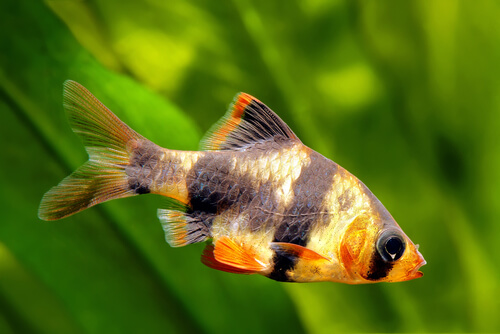
Generally, Barbs are quite resilient fish, though the smaller barb species may be somewhat more fragile, particularly with regards to injury and handling, and common pests and diseases. By keeping your tank clean and temperatures and pH levels at peak conditions, and feeding a proper diet your small barbs, and tank mates will be in good health.
Nevertheless, here are a few common health issues that you should look out for;
- Ich – A parasitic condition causing white spots on your fish.
- Swim Bladder Disease – Infection in the swim bladder, which keeps your fish buoyant, causing them to struggle to keep upright.
- Fin Rot – An infection causing patches and ulcers on the fins and eventually the body of your fish.
- Dropsy – A dire disease that is hard to cure, causing scales to stick out and the fish to become bloated.
Most of these issues can be treated with antibiotics and medication for specific conditions. The fish will have to be placed in a separate tank with higher temperatures and clean water conditions. You can read more about common freshwater fish conditions on our site; “Goldfish Behavior Before Death”.
Breeding Barb Fish
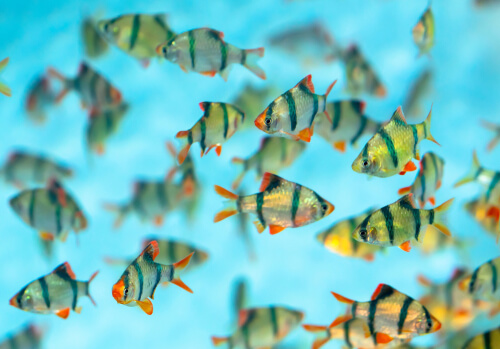
Barb fish in general are easy to breed if you would like to go this route. A separate breeding tank with plenty of floating and rooted plants and higher temperatures will be required. You will need one male per female for spawning, and they must be removed after the eggs are laid.
Most species will hatch within a day and be free-swimming the next day. However, I highly recommend that you consider each smaller barb species specifically should you want to breed your fish.
Small Barb Fish Species For Your Tank
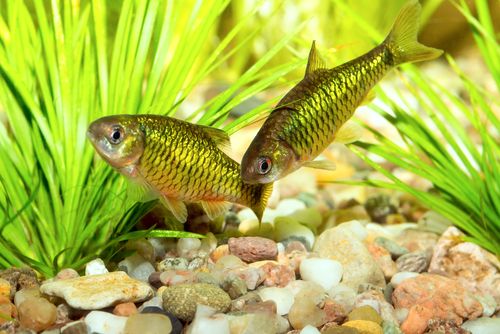
So, finally, we get to the topic, following the general care guidelines you should easily be able to keep any of these smaller Barb species;
1. Jae Barb (Enteromius Jae)
The Jae Barb is (4cm) 1.58 inches and native to Congo. It has red fins and a beige-to-brown body. It is a tropical fish that enjoys slightly more acidic water, and cooler temperatures. It is a peaceful schooling fish that gets along well with other tank mates.
2. Butterfly Barb (Enteromius Hulstraerti)
The Butterfly Barb is around 3.5cm (1.4 Inches) in size and is native to Congo. They are among the smaller barbs that thrive in the coldest water temperatures, and soft acidic conditions, with less current. Butterfly Barbs have a Pale body, blunt head, and yellow fins, with a translucent Caudal fin, and bold blue/black splotches in the males.
3. Lipstick Barb (Pethia Erythromycter)
Quite an entertaining barb fish, the Lipstick Barb is around 4 cm (1.58 Inches), with a silver body, black blotch on the tail, and a bright red top lip resembling Lipstick. It is native to Myanmar and enjoys cooler water conditions with an acidic to neutral pH. The Shoaling fish is peaceful and gets along with many other species.
4. Black Ruby Barb (Pethia Nigrofasciata)
The Black Ruby Barb is a magnificent specimen, barely under 2 inches at 1.97 inches (5.5cm). It originates from Sri Lanka and is a friendly schooling fish with striking colors, in both males and females. They are a dark ruby red, with red and black fins, purple pelvic fins, and black markings on the scales. The barbs are hardy and enjoy cool slightly acidic water conditions.
5. Cherry Barb (Puntius Titteya)
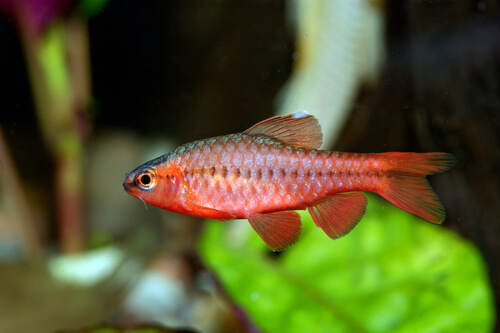
Cherry Barbs are quite well-known and popular for their charming red and orange coloring that illuminates your tank. They have a surprisingly long lifespan of between 4-7 years and are slightly larger at 5 cm (1.97 Inches).
Similarly, the Cherry Barb is native to Sri Lanka. Cherry Barbs are one of the most peaceful barb species if kept in groups of 6 or more, they prefer warmer water and are content with most water conditions.
6. Drape Fin Barb (Oreichthys Crenuchoides)
A peaceful and active smaller barb species of 5cm (1.97 Inches), that is tricky, because it prefers higher water temperatures that are much more neutral, than most other Barb species. The Drape Fin Barb has a silver body with black splashes on the scales a black spot on the tail, and a flowing drape Dorsal fin that is yellow with black specks.
The female looks similar however, has duller colors, and a smaller dorsal fin. Drape Fin Barbs are native to India and enjoy slow-flowing waters with moderate hardness.
7. Eight Banded False Barb (Eirmotus Octozona)
A gorgeous Thailand inherent barb species, like the African banded and Five Banded barbs in appearance. It has a yellow/red body with 8 dark bars from the snout up to the caudal peduncle. The barb is very small, 3.5 cm (1.38) inches, and quite shy, particularly when feeding. It is very versatile in terms of water conditions, however, difficult to keep with other species, and should only be kept with Dwarf banded barbs, and other Banded Barb species.
8. Gelius Barb (Pethia Gelius)
Also known as the Dwarf Golden barb is a very small barb species, 3.8 cm (1.5 Inches), that can be kept in groups of five, and in a 10-gallon tank. They generally have pale yellow bodies with black lateral stripes, and three black blotches on the body, though there are some color variations.
The fish species is found in quite a few countries, and the males are generally more colorful. They prefer slightly acidic and much cooler water conditions.
9. Indian High Fin Barb (Oreichthys Cosuatis)
Very similar to the Butterfly barb, with a few small differences, it is a rare small barb species found in India, Bangladesh, Nepal, and Thailand. The High Fin Barb is silver/bronze in color with large scales and a transparent dorsal fin that has black contrasting markings on the top of the fin, there are red ventral fins and there is a black spot on the anal fin.
They are quite timid, and shy barbs that are 4.5 cm (1.57 Inches) in size. The High Fin Barbs prefer slightly acidic to neutral water conditions, and higher temperatures.
Final Thoughts
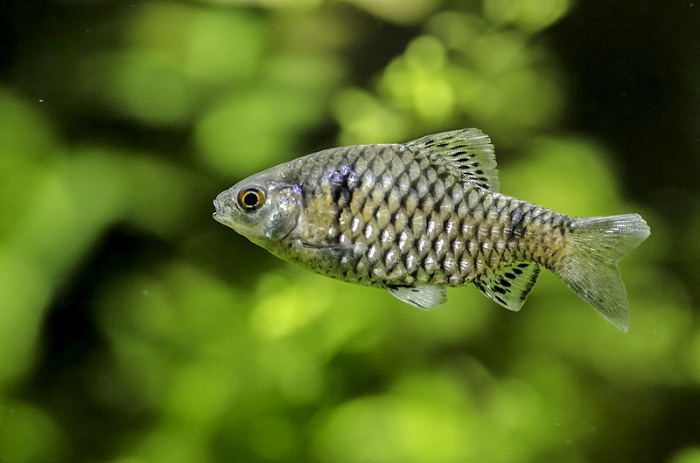
Some of the mentioned Barb species are quite rare. Smaller barbs are perfect for smaller well planted, and nano tanks, they are a colorful addition to any communal tank, though tank mates should be selected with care. As you can see from our list each species has its own unique preferences and temperament, though they are generally peaceful shoaling fish.


